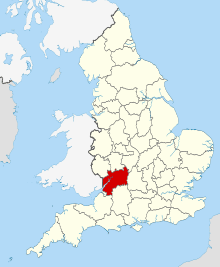Winchcombe Abbey
Winchcombe Abbey is a now-vanished Benedictine abbey in Winchcombe, Gloucestershire, this abbey was once the capital of Mercia, an Anglo Saxon kingdom at the time of the Heptarchy in England. The Abbey was founded c. 798 for three hundred Benedictine monks, by King Offa of Mercia or King Kenulf. In its time, it was the burial place of two Mercian princes, Kenulf and his son St. Kenelm.
The abbey was refounded in 970 after the disruptions of the Danish invasions, and the first abbot of the new establishment was Germanus of Winchester.[1]
The Abbey itself was in the grounds to the east end of the parish church of St Kenelm. Many pilgrims visited St. Kenelm's tomb in the early middle ages, and the Abbey thus became very rich. At its heyday, Winchcombe Abbey alone owned 25,300 acres (102 km²) in 13 parishes. Indeed, Snowshill Manor was owned by Winchcombe Abbey from 821 until the Dissolution of the Monasteries. In the early sixteenth century Winchcombe Abbey was known as a centre of learning under Abbot Richard Kidderminster (1488-1527), who was also a renowned preacher and acted as an ambassador for Henry VII. The quality of the stonemasons at Winchcombe was known to be very high, and it was a Winchcombe master mason who built the Divinity School at Oxford.
Winchcombe Abbey was surrendered to the Crown and then demolished in 1539. Some of its stones can still be found in Winchcombe; for example the lintel over the abbey gate now rests over the gate of what was once the George Inn. Fragments of the abbey can still be seen in various places in Winchcombe, notably the Corner Cupboard Inn on the Cheltenham road. A stone cross was erected in the 19th century to mark the centre of the abbey tower.[2] Very little now remains of the Abbey; more remains of its great nearby rival, Hailes Abbey.
Timeline for Winchcombe Abbey
- 798 - King Kenulf of Mercia gives instructions for building an abbey
- 811 - Winchcombe Abbey is dedicated by Wulfred, Archbishop of Canterbury
- 1042-1066 - During Edward the Confessor's reign Winchcombe Abbey becomes one of the most powerful Benedictine monasteries in the country
- 29 August, 1151 - Fire destroys much of Winchcombe, including the Abbey
- 1239 - Re-building of the Abbey completed
- 23 December, 1539 - Winchcombe Abbey is surrendered to the crown and the monks are pensioned off. The Abbey buildings are quickly demolished the stone being re-used in other buildings
See also
References
- ↑ Knowles, David; London, Vera C. M.; Brooke, Christopher (2001). The Heads of Religious Houses, England and Wales, 940–1216 (Second ed.). Cambridge: Cambridge University Press. p. 78. ISBN 0-521-80452-3. Cite uses deprecated parameter
|coauthors=(help) - ↑ "St Kenelm's Trail". Retrieved 2009-05-09.
The great Benedictine Abbey, known as St Mary and St Kenelm from 969, has disappeared more completely than almost any other of comparable stature. The land on which it stood is now in private ownership and inaccessible. From the churchyard however may be seen a stone cross in the grounds of the adjacent property. This was erected in the nineteenth century to mark the centre of the tower of the former monastery.
Coordinates: 51°57′12″N 1°58′1″W / 51.95333°N 1.96694°W

